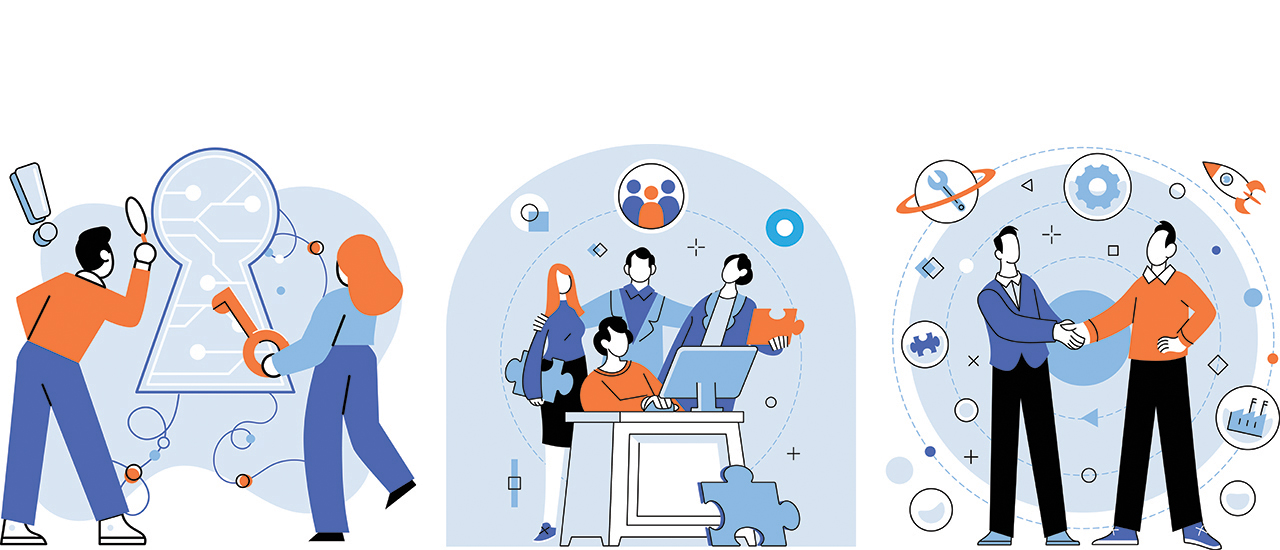
Building High Performance Teams
Tuesday, April 25, 2023
Research has shown that diverse teams outperform those that are less diverse. We know that today’s college students will be entering the most diverse workforce in history. It is more multigenerational, multicultural and multi-gendered than ever before, a trend that will not abate any time soon. The Interdisciplinary Team (IDT) projects we created at the Buccino Leadership Institute allow students to experience the challenges of building and leading diverse teams in a unique way.
Interdisciplinary Team Projects
IDT projects are a semester-long, low-stakes learning lab of team dynamics. Teams of eight to nine students choose a project that will positively impact the Institute, the University and/or the larger community. Each team of students chooses a team leader and spends the semester developing the project with a culminating team presentation to their class.
In the introductory IDT project program, Institute faculty determine the composition of the teams and provide a list of projects they are to choose from. In the advanced IDT project program, which takes place the following year, the students choose the projects and teams. Some of the unique features of this project include our method for project selection and the drafting of team members. Students from across the University are invited to pitch their best ideas. The class votes on the best pitches to determine which projects will be implemented. We have had an eclectic array of project ideas: a sports leadership camp for underprivileged youth, a professional clothing closet for students in need, a student club dedicated to public-speaking skills, and a get-out-the-vote civil engagement project, to name but a few.
Learning from IDTs
The Draft
One of the most exciting parts of our projects is the advanced IDT project draft.
IDT leaders participate in a live, fantasy football-style “snake” draft, during which
they get to draft and “hire” their team members. The only rule of the draft is that
leaders must select at least one member from every one of the six participating colleges/schools
at the University to be part of their team.
To choose their draft picks, leaders review several supporting elements. The DISC assessment measures behaviors including dominance, influence, steadiness and compliance to determine how we react and communicate in situations. Leaders can use the DISC assessment results of their classmates to ensure they have team members of differing styles and diversity of thought.
In addition, leaders review a two-minute personal pitch recorded by each student, which is used to assist leaders in determining fit and finding team members with the particular skills needed to complete the project. Leaders are also given access to how each student in the draft voted during the project pitches to determine which students were most enthusiastic about their project.
When the draft is complete, faculty members discuss with the leaders their methodology in selecting their team. Did they take diversity into account? What information was most useful in helping them make their decisions? As the team works together toward the goal, faculty mentors observe and discuss with the team the benefits of diversity and the drawbacks when there is a lack of it.
One faculty mentor pointed out to a team that all of the behind-the-scenes tasks had been assigned to the women on one of the teams, while the forward-facing tasks had been assigned to the men. The team learned important lessons about unconscious bias and women’s unique challenges in leadership positions.
Students experiment with different leadership styles to identify the type of leader they wish to become. They develop strong interdisciplinary relationships that will enhance their network as they go forward into their careers.
Effective Communication
Student leaders learn how to assert themselves and contribute to a team. They learn
that others have different perspectives and different talents. They observe their
peers to gain an understanding of what they value and dislike in leadership styles.
They reflect on the feedback they receive from peers and their team mentors to enhance
their performance in the next year. In the advanced IDT project, students employ more
effective communication strategies, observing their team members’ nonverbal cues,
employing attentive listening strategies and asking introverted team members for their
input. They spend time working on conflict management rather than avoidance.
One IDT leader noticed one of her team members was not as present and engaged as his counterparts, so she met with him separately twice to understand why and address his concerns. She paired him with a team member he trusted to complete a portion of the project, and he started to engage more at meetings and became a valued contributor to the final product. He was proud of his involvement.
Strategy
Students often start with an egalitarian approach to their team presentations in the
first year. Often, every team member is given a speaking role in the final presentation.
More often in the advanced IDT projects, presentations are made by those most skilled
in presenting or those with the strongest leadership roles on the team. These presentations
are more professional, more polished, and flow better.
In the introductory IDT projects, decisions are frequently made by the most gregarious or confident team member sharing an idea and the rest of the team following. In the advanced IDT, students pay more attention to decision-making processes. The team leader is more involved in the strategy around decision making, based on their leadership style. The team is more in tune with how decision making aligns with goals. Students are more strategic about asking for disparate voices and counter opinions to identify blind spots and improve the final product.
One team leader began his first meeting like this: “I know this project originates with my idea, but this is as much your project as mine, and I know you will have many ideas I could not come up with, so I want to hear your voices, I want your pushback. I want us to be in this together.”
Students build a level of professionalism in learning to work with one another over the course of the semester. In the advanced project, they learn to invest more time in goal setting, strategy, intentionality and reflection.
Feedback
A faculty or upperclassmen mentor is assigned to each team to observe and give both
team and individual feedback. Students also watch a recorded session to observe the
team’s behaviors and their own behaviors with a more objective eye. They are often
shocked by how little they participated in the meeting or how rude something they
said sounded.
In their peer feedback, team members are ranked by their fellow team members in the order of their contributions, from most valuable to least valuable. Students also provide quantitative scores and qualitative feedback to justify those scores. For many, this is the first time they’ve ever received authentic feedback about their leadership effectiveness. While uncomfortable, the effects can be profound. One freshman was ranked lowest among his teammates. He accepted the feedback from his team and used it to improve his skills and attitude. He worked with the professional coach assigned to him to work on his technique and style during his advanced IDT process, and, ultimately, was rated the most valuable member on that team.
Team Building
One of the advanced teams decided in their first meeting not to do any icebreakers
to get to know one another because the leader thought they were a waste of time. By
the middle of the semester, in individual check-ins with the leader, the team expressed
their concerns that they didn’t feel united in purpose, that they didn’t know each
other well enough to trust their fellow teammates, and that they were uncomfortable
in meetings.
The leader spent the entire next meeting, which should have been one of their project’s most productive content meetings, doing a team-building experience to make up for the misstep and bring the team together. After doing exercises to build community and get vulnerable together, they worked more productively and effectively toward the goal.
Adaptability
Students learn the importance of agility and calm through adversity. In 2020, our
teams started with in-person meetings and were preparing for an in-person project
presentation at the culmination of their IDT projects. With the pivot to remote learning
in March due to the global COVID-19 pandemic, the teams had to adapt quickly to a
new working environment. One of our teams had planned an in-person exercise to show
off the importance of personal interaction in the classroom. They were forced to change
their entire focus for a remote audience.
Another team was preparing an onboarding activity for new Buccino Scholars. They had their hearts set on an escape room activity, but after research found that it would be cost prohibitive, they had to pivot their project halfway through the semester.
Outcomes
After the semester, many of our teams have decided to remain together and continue
their projects. Some have turned their IDT project into sustaining initiatives in
the Institute. These projects have included many of the ideas we mentioned in the
project selection section. The Pirate’s Closet is now housed in the University’s Career
Center with more than 300 items of free professional attire available to all students
on campus to use for interviews, networking events, presentations and more. The IDT
maintains the Closet and secures donations for its upkeep.
The Voice of Leadership has biweekly meetings for students interested in improving their public-speaking skills. The club, headed by the IDT, allows all students opportunities to learn public speaking techniques in a supportive environment, practice giving presentations to the group and receive feedback.
Students consistently rate their IDT projects among the most impactful elements of their leadership development at Seton Hall. Through this experience, students can experiment with different leadership styles and identify the type of leader they wish to become. They develop strong interdisciplinary relationships that will enhance their network as they go forward into their careers. They learn how to harness the power of having diverse perspectives and leadership styles to create positive outcomes for their team. L
This article originally appeared in the Spring 2023 issue of In the Lead magazine, from The Stillman School of Business and its Business Leadership Center. The bi-annual magazine focuses on leadership perspectives from the field of health care, with content that is curated from leaders across the industry who share lessons learned from real-world experiences.
Categories: Business

